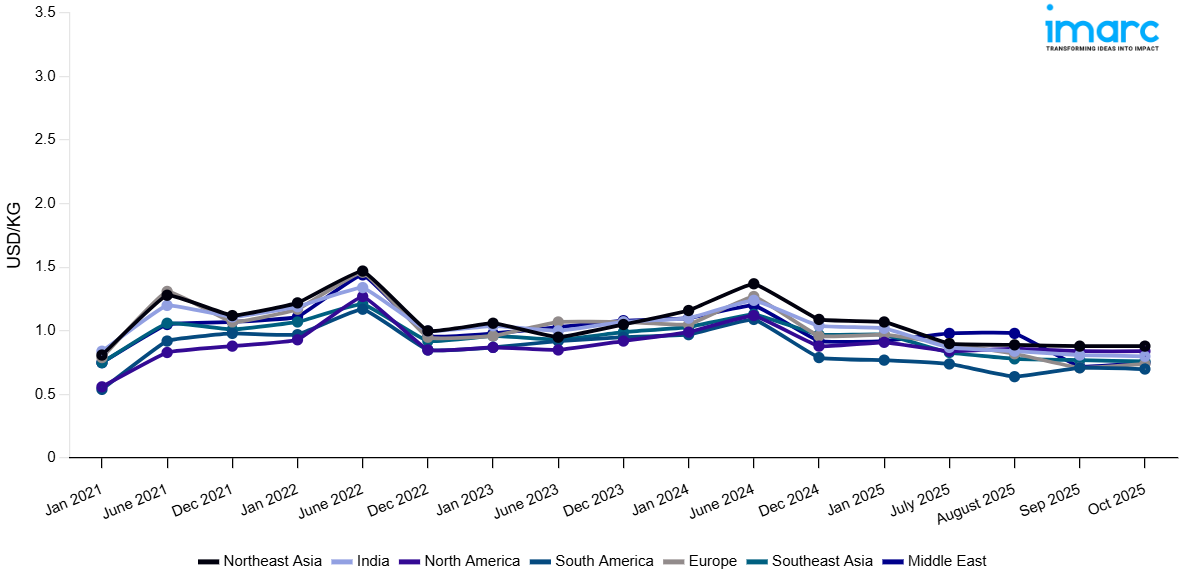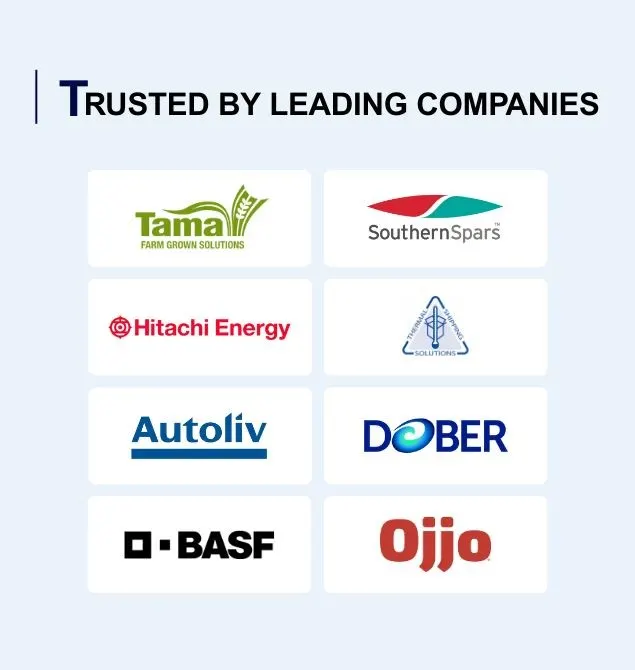
Benzene Prices, Trend, Chart, Demand, Market Analysis, News, Historical and Forecast Data Report 2025 Edition
Benzene Price Trend, Index and Forecast
Track real-time and historical benzene prices across global regions. Updated monthly with market insights, drivers, and forecasts.
Benzene Prices October 2025
| Region | Price (USD/Kg) | Latest Movement |
|---|---|---|
| Northeast Asia | 0.88 | 0.7% ↑ Up |
| Europe | 0.74 | 5.0% ↑ Up |
| India | 0.80 | -1.3% ↓ Down |
| South America | 0.70 | -1.1% ↓ Down |
| Middle East | 0.75 | 4.3% ↑ Up |
| Southeast Asia | 0.76 | -2.4% ↓ Down |
| North America | 0.84 | -0.9% ↓ Down |
Benzene Price Index (USD/KG):
The chart below highlights monthly benzene prices across different regions.

Get Access to Monthly/Quaterly/Yearly Prices, Request Sample
Market Overview Q3 Ending September 2025
Northeast Asia: In Northeast Asia, benzene prices eased slightly as downstream demand from styrene and phenol production softened. Adequate supply from regional crackers kept inventories stable, while export activity provided limited support. The benzene price index reflected restrained buying interest from polymer and resin manufacturers, with production costs stable due to consistent feedstock naphtha availability. Overall, balanced supply-demand dynamics prevented sharper price corrections despite the bearish sentiment.
Europe: In Europe, benzene prices declined sharply as weak industrial demand and subdued automotive and construction activity curtailed procurement. High stock levels combined with lower derivative consumption, particularly in styrene and caprolactam, weighed heavily on the market. The benzene price index signaled significant downward momentum as imports increased competition, while falling feedstock prices compounded bearish conditions. Producer margins came under pressure, leading to a pronounced drop in regional price trends.
India: In India, benzene prices registered a moderate decline amid weaker demand from downstream resin and adhesive industries. Domestic supply levels remained steady, but limited export opportunities restricted market support. The benzene price index highlighted cautious procurement strategies by industrial buyers, while reduced momentum in textile and construction-related derivatives further pressured the market. Although crude oil fluctuations influenced production costs, demand-side weakness drove overall bearishness.
South America: In South America, benzene prices rose sharply, supported by strong demand from petrochemical derivatives such as styrene and phenol. Supply constraints in certain distribution hubs further amplified the upward movement. The benzene price index reflected increased industrial procurement, with downstream manufacturers actively replenishing inventories. Seasonal demand strength, coupled with limited import alternatives, bolstered pricing momentum and created a firm market environment across the region this quarter.
Middle East: In the Middle East, benzene prices dropped steeply as excess regional supply outpaced lackluster downstream demand. Abundant feedstock availability from refineries and weak consumption from resin and plastics industries contributed to oversupply. The benzene price index showed a clear downward trajectory as limited export opportunities failed to absorb surplus volumes. Buyers remained cautious, further undermining market confidence and reinforcing bearish pricing conditions.
Southeast Asia: In Southeast Asia, benzene prices moved marginally lower as demand from downstream derivatives remained subdued. Balanced domestic production ensured stable supply, while exports to external markets failed to generate sufficient upward traction. The benzene price index pointed to steady but muted activity in end-use applications such as packaging and textiles. Overall, the market witnessed stable fundamentals, though weak buying interest prevented meaningful recovery.
North America: In North America, benzene prices decreased as seasonal demand from styrene and resin industries weakened. Domestic supply was steady, but downstream consumption failed to provide sufficient support. The benzene price index indicated lower momentum across industrial applications, with reduced automotive and packaging sector demand adding pressure. Import competition further reinforced the bearish tone, leaving regional producers with limited pricing flexibility.
Benzene Price Trend, Market Analysis, and News
IMARC's latest publication, “Benzene Prices, Trend, Chart, Demand, Market Analysis, News, Historical and Forecast Data Report 2025 Edition,” presents a detailed examination of the benzene market, providing insights into both global and regional trends that are shaping prices. This report delves into the spot price of benzene at major ports and analyzes the composition of prices, including FOB and CIF terms. It also presents detailed benzene prices trend analysis by region, covering North America, Europe, Asia Pacific, Latin America, and Middle East and Africa. The factors affecting benzene pricing, such as the dynamics of supply and demand, geopolitical influences, and sector-specific developments, are thoroughly explored. This comprehensive report helps stakeholders stay informed with the latest market news, regulatory updates, and technological progress, facilitating informed strategic decision-making and forecasting.
Benzene Industry Analysis
The global benzene industry size reached USD 66.15 Billion in 2024. By 2033, IMARC Group expects the market to reach USD 87.83 Billion, at a projected CAGR of 3.04% during 2025-2033. Growth is driven by rising consumption of benzene in petrochemical derivatives such as styrene, cumene, and cyclohexane, alongside expanding applications in plastics, resins, and synthetic fibers, which continue to underpin long-term global demand.
Latest developments in the benzene industry:
- March 2025: ADNOC and OMV merged their polyolefin businesses, Borouge and Borealis, and acquired Nova Chemicals in a USD 13.4 billion deal. The move creates a global petrochemicals powerhouse and strengthens the companies' capabilities in complex benzene-derived value chains.
- September 2024: Tamilnadu Petroproducts Ltd. announced plans to expand its Linear Alkyl Benzene (LAB) and Caustic Soda plants with an investment of INR 405 Crore by FY26. This expansion, increasing LAB capacity to 145 TPA, will boost production, enhancing India's Benzene segment growth and capacity.
- March 2023: Saudi Basic Industries Corporation reached a deal with North Huajin Chemical and Panjin Xincheng to start building a refinery and petrochemical complex in China’s Liaoning province. The project was positioned as a significant milestone in China–Saudi cooperation on downstream petrochemicals.
- March 2023: ExxonMobil Corporation launched its long-planned project to increase the capacity of processing light crude oil by 250,000 barrels per day at ExxonMobil Product Solutions Co.’s integrated refining and petrochemicals complex in Beaumont, Texas. The expansion significantly boosted ExxonMobil’s benzene and petrochemical production footprint on the U.S. Gulf Coast.
- December 2022: Sinopec signed a joint venture agreement to collaborate on its 1.2 million tons-per-year ethane cracker facility in Tianjin Province, China. The deal paved the way for greater international cooperation in large-scale petrochemical production, including benzene derivatives.
Product Description
Benzene (C₆H₆) is an aromatic hydrocarbon and one of the most important petrochemical building blocks. It is a colorless, volatile, and highly flammable liquid with a sweet odor. Industrially, benzene is primarily produced through catalytic reforming, toluene hydrodealkylation, and steam cracking of hydrocarbons. Its chemical structure, featuring a stable ring of six carbon atoms, makes it a fundamental precursor in organic chemistry. Benzene is extensively used in the production of styrene, phenol, aniline, cumene, and cyclohexane, which serve as intermediates for plastics, synthetic fibers, detergents, and resins. Despite its industrial significance, benzene is classified as a hazardous substance due to its toxicity and carcinogenicity, requiring stringent handling and regulatory compliance.
Report Coverage
| Key Attributes | Details |
|---|---|
| Product Name | Benzene |
| Report Features | Exploration of Historical Trends and Market Outlook, Industry Demand, Industry Supply, Gap Analysis, Challenges, Benzene Price Analysis, and Segment-Wise Assessment. |
| Currency/Units | US$ (Data can also be provided in local currency) or Metric Tons |
| Region/Countries Covered | The current coverage includes analysis at the global and regional levels only. Based on your requirements, we can also customize the report and provide specific information for the following countries: Asia Pacific: China, India, Indonesia, Pakistan, Bangladesh, Japan, Philippines, Vietnam, Thailand, South Korea, Malaysia, Nepal, Taiwan, Sri Lanka, Hongkong, Singapore, Australia, and New Zealand* Europe: Germany, France, United Kingdom, Italy, Spain, Russia, Turkey, Netherlands, Poland, Sweden, Belgium, Austria, Ireland, Switzerland, Norway, Denmark, Romania, Finland, Czech Republic, Portugal and Greece* North America: United States and Canada Latin America: Brazil, Mexico, Argentina, Columbia, Chile, Ecuador, and Peru* Middle East & Africa: Saudi Arabia, UAE, Israel, Iran, South Africa, Nigeria, Oman, Kuwait, Qatar, Iraq, Egypt, Algeria, and Morocco* *The list of countries presented is not exhaustive. Information on additional countries can be provided if required by the client. |
| Information Covered for Key Suppliers |
|
| Customization Scope | The report can be customized as per the requirements of the customer |
| Report Price and Purchase Option |
Plan A: Monthly Updates - Annual Subscription
Plan B: Quarterly Updates - Annual Subscription
Plan C: Biannually Updates - Annual Subscription
|
| Post-Sale Analyst Support | 360-degree analyst support after report delivery |
| Delivery Format | PDF and Excel through email (We can also provide the editable version of the report in PPT/Word format on special request) |
Key Benefits for Stakeholders:
- IMARC’s report presents a detailed analysis of benzene pricing, covering global and regional trends, spot prices at key ports, and a breakdown of Ex Works, FOB, and CIF prices.
- The study examines factors affecting benzene price trend, including raw material costs, supply-demand shifts, geopolitical impacts, and industry developments, offering insights for informed decision-making.
- The competitive landscape review equips stakeholders with crucial insights into the latest market news, regulatory changes, and technological advancements, ensuring a well-rounded, strategic overview for forecasting and planning.
- IMARC offers various subscription options, including monthly, quarterly, and biannual updates, allowing clients to stay informed with the latest market trends, ongoing developments, and comprehensive market insights. The benzene price charts ensure our clients remain at the forefront of the industry.
Key Questions Answered in This Report
The benzene prices in October 2025 were 0.88 USD/KG in Northeast Asia, 0.74 USD/KG in Europe, 0.80 USD/KG in India, 0.70 USD/KG in South America, 0.75 USD/KG in Middle East, 0.76 USD/KG in Southeast Asia, and 0.84 USD/KG in North America.
The benzene pricing data is updated on a monthly basis.
We provide the pricing data primarily in the form of an Excel sheet and a PDF.
Yes, our report includes a forecast for benzene prices.
The regions covered include North America, Europe, Asia Pacific, Middle East, and Latin America. Countries can be customized based on the request (additional charges may be applicable).
Yes, we provide both FOB and CIF prices in our report.
Need more help?
- Speak to our experienced analysts for insights on the current market scenarios.
- Include additional segments and countries to customize the report as per your requirement.
- Gain an unparalleled competitive advantage in your domain by understanding how to utilize the report and positively impacting your operations and revenue.
- For further assistance, please connect with our analysts.
Why Choose Us
IMARC offers trustworthy, data-centric insights into commodity pricing and evolving market trends, enabling businesses to make well-informed decisions in areas such as procurement, strategic planning, and investments. With in-depth knowledge spanning more than 1000 commodities and a vast global presence in over 150 countries, we provide tailored, actionable intelligence designed to meet the specific needs of diverse industries and markets.
1000
+Commodities
150
+Countries Covered
3000
+Clients
20
+Industry
Robust Methodologies & Extensive Resources
IMARC delivers precise commodity pricing insights using proven methodologies and a wealth of data to support strategic decision-making.
Subscription-Based Databases
Our extensive databases provide detailed commodity pricing, import-export trade statistics, and shipment-level tracking for comprehensive market analysis.
Primary Research-Driven Insights
Through direct supplier surveys and expert interviews, we gather real-time market data to enhance pricing accuracy and trend forecasting.
Extensive Secondary Research
We analyze industry reports, trade publications, and market studies to offer tailored intelligence and actionable commodity market insights.
Trusted by 3000+ industry leaders worldwide to drive data-backed decisions. From global manufacturers to government agencies, our clients rely on us for accurate pricing, deep market intelligence, and forward-looking insights.
 Request Customization
Request Customization
 Inquire Before Buying
Inquire Before Buying
 Speak to an Analyst
Speak to an Analyst Request Brochure
Request Brochure




.webp)




.webp)












